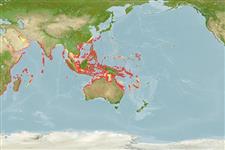Environment: milieu / climate zone / depth range / distribution range
Écologie
marin récifal; profondeur 1 - 40 m (Ref. 9710). Tropical; 30°N - 30°S
Indo-West Pacific: Red Sea and East Africa to Papua New Guinea, north to Miyakejima, Japan (Ref. 559), south to Australia and New Caledonia (Ref. 2142).
Taille / Poids / Âge
Maturity: Lm ? range ? - ? cm
Max length : 14.5 cm TL mâle / non sexé; (Ref. 11441)
Épines dorsales (Total): 8; Rayons mous dorsaux (Total): 9; Épines anales 2; Rayons mous anaux: 8; Vertèbres: 14. Distinguished by having the following characteristics: Dorsal-fin rays VII-I, 9; anal-fin rays II,8; pectoral-fin rays 14; pelvic-fin rays I,5; pored lateral line scales 25; predorsal scales 5; circumpeduncular scales 12; total gill rakers 24, developed gill rakers, 21; without oblique dark bars on cheek (Ref. 93839). Color in life coppery with iridescence, paler posteriorly; a blackish stripe, bordered by a blue line, running from front of snout through eye and beyond; a narrow blue streak on maxilla. Large and oblique mouth; median predorsal scales 5; preopercular ridge smooth with posterior and most of ventral margin serrate. Black bar encircling caudal peduncle present in both young and adult phases (Ref. 02142).
Inhabits holes in rocks or under ledges in shallow waters. Known to occur in mixed aggregates with Apogon apogonoides during summer and autumn, but form separate aggregates in winter and spring (Ref. 559 and 637). Forms aggregations (Ref 90102).
Life cycle and mating behavior
Maturité | Reproduction | Frai | Œufs | Fécondité | Larves
Mouthbrooders (Ref. 240). Distinct pairing during courtship and spawning (Ref. 205).
Randall, J.E., T.H. Fraser and E.A. Lachner, 1990. On the validity of the Indo-Pacific cardinalfishes Apogon aureus (Lacepède) and A. fleurieu (Lacepède), with description of a related new species from the Red Sea. Proc. Biol. Soc. Wash. 103(1):39-62. (Ref. 2142)
Statut dans la liste rouge de l'IUCN (Ref. 130435)
Menace pour l'homme
Harmless
Utilisations par l'homme
Pêcheries: intérêt commercial mineur; Aquarium: Commercial
Plus d'informations
RéférencesAquacultureProfil d'aquacultureSouchesGénétiqueElectrophoresesHéritabilitéPathologiesTraitementNutrientsMass conversion
Outils
Articles particuliers
Télécharger en XML
Sources Internet
Estimates based on models
Preferred temperature (Ref.
123201): 24.7 - 29, mean 27.5 °C (based on 804 cells).
Phylogenetic diversity index (Ref.
82804): PD
50 = 0.5000 [Uniqueness, from 0.5 = low to 2.0 = high].
Bayesian length-weight: a=0.01148 (0.00705 - 0.01869), b=3.16 (3.03 - 3.29), in cm total length, based on LWR estimates for this species & Genus-body shape (Ref.
93245).
Niveau trophique (Ref.
69278): 3.6 ±0.54 se; based on food items.
Résilience (Ref.
120179): Haut, temps minimum de doublement de population inférieur à 15 mois (Preliminary K or Fecundity.).
Fishing Vulnerability (Ref.
59153): Low vulnerability (10 of 100).
Nutrients (Ref.
124155): Calcium = 105 [54, 166] mg/100g; Iron = 0.815 [0.484, 1.351] mg/100g; Protein = 18.7 [17.5, 19.8] %; Omega3 = 0.127 [0.076, 0.203] g/100g; Selenium = 31.4 [17.4, 58.6] μg/100g; VitaminA = 59.1 [17.6, 192.7] μg/100g; Zinc = 1.42 [0.95, 2.04] mg/100g (wet weight);
